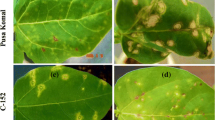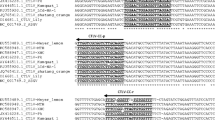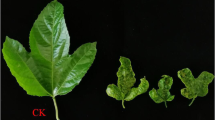Abstract
Reverse transcription-polymerase chain reaction (RT-PCR) was developed for the detection of viruses from Daphne odora plants in this study. Five sets of primers were designed for the specific detection of five different viruses, Daphne virus Y (DVY, Potyvirus), Cucumber mosaic virus (CMV, Cucumovirus), Daphne virus S (DVS, Carlavirus), Cycas necrotic stunt virus (CNSV, Nepovirus), and Watermelon mosaic virus (WMV, Potyvirus) in collected Daphne plants. RT-PCR could successfully detect the viruses from the Daphne plants. Two potyviruses (DVY and WMV), CNSV, CMV and DVS were frequently detected in >85% samples examined in this study. CNSV was the most prevalent virus (78%), and the infection rate for the three viruses WMV, CMV and DVS was >60%. These results demonstrate that virus diseases on Daphne plants are extremely severe and widespread in Korea. It is especially notable that mixed virus infections with more than three different viruses were very common and 12% of Daphne plants were infected by the five viruses. The results suggest that five primer sets developed in this study can successfully detect the target viruses and can be useful for the monitoring of virus incidence and indexing of the virus-free Daphne plants.
Similar content being viewed by others
Avoid common mistakes on your manuscript.
Introduction
Daphne is a one of the popular evergreen ornamental shrubs worldwide. The genus Daphne belongs to the family Thymelaeaceae. Producers commercially propagate many varieties of Daphne plants by cuttings in Korea; the risk to Daphne plants being infected with several viruses is therefore high when sources of plants are infected.
In particular, Daphne-infecting viruses such as Cycas necrotic stunt virus (CNSV, Nepovirus), Carnation mottle virus (CaMoV, Carmovirus), Cucumber mosaic virus (CMV, Cucumovirus), Daphne virus S (DVS, Carlavirus), Daphne virus X (DVX, Potexvirus), Daphne virus Y (DVY, Potyvirus), Daphne mosaic virus (DapMV, Potyvirus), a tobamovirus, Alfalfa mosaic virus, Arabis mosaic virus, Tobacco ringspot virus, and some other poorly characterised rod-shaped or isometric viruses (Forster and Milne 1975, 1978a, b; Fránová et al. 2006; Lee et al. 2003, 2004, 2006a; Lee and Ryu 2006) have been reported.
Among the Daphne-infecting viruses, sequence information of the viral genomes is very limited at present. Complete genome sequences of DVS (Lee et al. 2003, 2006b), and DapMV (Fránová et al. 2006) and partial sequence of an isolate of CNSV (Lee and Ryu 2006) have been recently reported, but to date there is no sequence information for the other viruses such as DVX, DVY, and CMV from Daphne plants.
In order to obtain molecular information that may help to develop control measures for the viruses, we have determined some sequences of the viruses to develop the molecular detection method in this study. We identified five viruses from collected samples in this study, and all the samples were co-infected with at least three viruses. We report here the incidence of viruses on Daphne plants in Korea and the development of molecular detection methods for Daphne-infecting viruses from Daphne plants in Korea.
Materials and methods
Source of plants used for detection of viruses
In a total of 125 Daphne plants (Daphne odora vars ‘Marginata’, ‘Zuiko Nikshiki’) showing systemic chlorotic spots, mild mosaic systemic stunting with mosaic symptoms, and latent symptoms, were collected from nine nurseries in Seoul and Kyunggi province in 2003–2006. A survey was performed during the late spring to early summer. Some collected plants were maintained in a light/temperature-controlled glasshouse of the Seoul Women’s University in Seoul, Korea. All the plants were checked by RT-PCR and some by transmission electron microscopy (TEM) (Lee and Ryu 2006; Yoon and Ryu 2002).
Source of viruses
Five species of Daphne-infecting viruses, Daphne virus Y (DVY, Potyvirus), Cucumber mosaic virus (CMV, Cucumovirus), Daphne virus S (DVS, Carlavirus), Cycas necrotic stunt virus (CNSV, Nepovirus), and Watermelon mosaic virus (WMV, Potyvirus), were originally obtained from the Plant Virus GenBank (http://www.virusbank.org) and used for positive controls for detection of each virus in this study.
Electron microscopy of purified virus preparations
Purified virions from infected leaves of originally infected Daphne plant were stained with 2% uranyl acetate and examined with a LEO 906 transmission electron microscope (Yoon and Ryu 2002).
Viral RNA analysis
Viral genomic RNAs were extracted from the purified virus particles by using SDS/proteinase K and phenol extraction method as described by Lee et al. (2003). Viral RNAs of different sizes were separated on a 1.4% denatured agarose gel and visualised by ethidium bromide staining (Sambrook et al. 1989).
Total extraction of RNAs from Daphne plants
Total RNAs were extracted from the collected Daphne leaf-tissues. All viral genomic RNAs were extracted with SDS-proteinase K/phenol method as described by Lee et al. (2004) and the Rneasy Plant Mini Kit (Qiagen, USA) according to the manufacturer’s protocol. Briefly, each sample of freeze-dried leaf tissues was ground in extraction buffer (50 mM Tris (pH 8.0), 0.1% SDS, 10 mM EDTA) with a sterilised pestle and mortar. Proteinase K (10 mg ml−1) was added to the crude sap preparation and incubated at 42°C for 10 min (Lee and Ryu 2006). The reaction mixture was extracted with phenol-chloroform and total RNAs were ethanol precipitated (Sambrook et al. 1989). The resulting precipitates of total RNAs were dissolved in RNase-free distilled water.
Design of primers for reverse transcription-polymerase chain reaction (RT-PCR)
To design specific-primers for Daphne-infecting viruses (CMV, DVY and WMV), cDNAs for individual virus genomic RNAs were generated by a cDNA library kit (Gibco BRL, MD), and resultant cDNA clones were sequenced in this study (Sanger et al. 1977). Nucleotide sequences of DVS and CNSV deposited in GenBank were obtained and used for detection of the viruses. Five sets of detection primers for the viruses were designed based on sequences of CMV, CNSV, DVS, DVY and WMV to amplify 650, 543, 950, 850 and 650 bp, respectively (Table 1).
RT-PCR detection of five different viruses from Daphne plants
Total nucleic acids were extracted from virus-infected leaves as described by Yoon and Ryu (2002), and used as templates for RT-PCR detection. RT was performed in a reaction mixture (20 μl) containing 2.5 mM MgCl2, 0.5 mM of each dNTP, 1 μl 50 pM of reverse primer, 1× buffer, 1 U RNasin (Roche, USA), and 2.5 U SSTII reverse transcriptase (Invitrogen, USA) at 42°C for 60 min. PCR was performed in 5 μl of the synthesised cDNA, 1× PCR buffer, 2.5 mM MgCl2, 0.04 U DNA polymerase Mix Taq (Roche, USA), and 1 μl 50 pM of each virus primers. PCR was performed in a thermal cycler (BioRad, USA). Denaturation was executed at 94°C for 3 min before starting PCR cycling. PCR cycle consisted of 30 s at 94°C, 30 s at 52°C, and 40 s at 68°C. A total of 35 cycles was performed, and cycling ended with final extension at 68°C for 10 min.
Results and discussion
Identification of Daphne-infecting viruses
Two types of virus particles, filamentous and isometric types, were found in purified preparations from originally infected Daphne plants (Fig. 1). Filamentous virus particles are typical of those of carlaviruses and potyviruses, 620 and 780 nm in length, respectively (Fig. 1a), and sequencing analyses demonstrated that carlavirus was identified as DVS and two potyviruses were identified as DVY and WMV. Isometric particles about 30 nm in length were also present in purified preparations (Fig. 1b), and they were identified as CNSV and CMV by sequence analysis in this study (data not shown). A total of nine RNA bands were observed on gel electrophoresis analysis, and we could identify and differentiate the RNA bands by sizes for genomic RNAs of the five viruses (Fig. 2).
RT-PCR detection of five viruses from Daphne plants
In this study, an efficient molecular detection method of Daphne-infecting viruses (CMV, CNSV, DVS, DVY and WMV) was developed and applied to the collection of Daphne plants. RT-PCR could successfully detect the five viruses by using the RT-PCR from cultivated D. odora plants in Korea (Fig. 3), confirmed by partial sequence analyses of each virus. The existence and identification of CMV, DVY and WMV in this study constitute the first report for Daphne plants in Korea. To our knowledge, this is the first record of WMV from Daphne plants in the world.
High incidence of virus diseases and status of mixed infections of five viruses in Daphne plants
Of the 125 Daphne plants collected from nine nurseries, incidence of virus infection was >85%. Single virus infection was not detected and all the diseased Daphne samples were infected by at least three different viruses. CNSV was the most prevalent virus (78%), and the other three viruses such as WMV, CMV and DVS were >60% (Fig. 4a) suggesting virus diseases on Daphne plants are extremely severe at present. Especially, it is notable that mixed infections with more than three different viruses were very common (Fig. 4b) and 12% of Daphne plants were infected by the five viruses (Fig. 4b). Symptoms on virus-infected Daphne spp. included chlorotic spots, systemic warping and distortion on the leaves (data not shown).
Some cultivars of Daphne plants have been cultivated in the southern areas and in indoor gardens in Korea. There was currently no report of virus diseases in Daphne plants in Korea up until 1999. However, new severe systemic virus-like symptoms have been observed on leaves of cultivated Daphne plants (D. odora) in Korea since 2000 (Lee et al. 2003; Lee and Ryu 2006). The presence of symptoms significantly influence the quality of plants used for commercialisation, as well as the growth of Daphne as a garden plant in Korea. The Daphne nurseries in Korea propagate the plants mainly by cuttings (Lee et al. 2003). Therefore, practically, many cultivated Daphne plants could be infected with various viruses originating from mother plant sources.
The molecular detection tool described here can be useful for the indexing of the virus from Daphne plants to eliminate virus-infected plants during the propagation of mother plants. The infection rate of the virus disease on Daphne plants is higher than expected, and therefore careful selection of virus-free plants for propagation is required to protect plants from the pathogenic virus.
References
Forster, R. L. S., & Milne, K. S. (1975). Survey of viruses infecting Daphne in New Zealand. New Zealand Journal of Agricultural Research, 18, 391–398.
Forster, R. L. S., & Milne, K. S. (1978a). Daphne virus S a carlavirus from Daphne-odora. New Zealand Journal of Agricultural Research, 21, 131–136.
Forster, R. L. S., & Milne, K. S. (1978b). Daphne virus X. Descriptions of plant viruses. no. 195 (p. 3). Kew, Surrey, UK: CMI/AAB.
Fránová, J., Petrzik, K., Lesemann, D. E., & Navrátil, M. (2006). Daphne mosaic virus (DapMV), a new potyvirus from Daphne mezereum in the Czech Republic. Archives of Virology, 151, 793–801. doi:10.1007/s00705-005-0668-9.
Lee, B. Y., Choi, S. H., & Ryu, K. H. (2003). Characterization of the 3′-terminal nucleotide sequence of two Korean isolates of Daphne virus S support its placement as a distinct species of Carlavirus. Archives of Virology, 148, 1915–1924. doi:10.1007/s00705-003-0161-2.
Lee, B. Y., Ha, J. H., & Ryu, K. H. (2006a). Daphne-infecting viruses in Korea and properties of Daphne virus S. Acta Horticulturae, 722, 55–58.
Lee, B. Y., Lim, H. R., Choi, J. Y., & Ryu, K. H. (2004). Development of molecular detection of three species of seed-transmissible viruses useful for plant quarantine. The Plant Pathology Journal, 20, 302–307.
Lee, B. Y., Min, B. E., Ha, J. H., Lee, M. Y., Paek, K. H., & Ryu, K. H. (2006b). Genome structure and the complete sequence of genome RNA of Daphne virus S. Archives of Virology, 151, 193–200. doi:10.1007/s00705-005-0606-x.
Lee, B. Y., & Ryu, K. H. (2006). Identification and molecular detection of Cycas necrotic stunt virus from Daphne odora plants in Korea. Horticulture, Environment, and Biotechnology, 47, 75–79.
Sambrook, J., Fritsch, E. F., & Maniatis, T. (1989). Molecular cloning: a laboratory manual (2nd ed.). New York: Cold Spring Harbor Laboratory Press.
Sanger, F., Nicklen, S., & Coulson, A. R. (1977). DNA sequencing with chain-terminating inhibitors. Proceedings of the National Academy of Sciences of the United States of America, 74, 5463–5467. doi:10.1073/pnas.74.12.5463.
Yoon, H. I., & Ryu, K. H. (2002). Molecular identification and sequence analysis of Ornithogalum mosaic virus from Iris plants. The Plant Pathology Journal, 18, 251–258.
Acknowledgements
This study was supported by a grant from the Institute of Natural Science of Seoul Women’s University in 2005 in Korea.
Author information
Authors and Affiliations
Corresponding author
Rights and permissions
About this article
Cite this article
Lee, B.Y., Ryu, K.H. Incidence of virus diseases and RT-PCR detection of Daphne-infecting viruses in Korea. Eur J Plant Pathol 124, 127–132 (2009). https://doi.org/10.1007/s10658-008-9399-6
Received:
Accepted:
Published:
Issue Date:
DOI: https://doi.org/10.1007/s10658-008-9399-6








